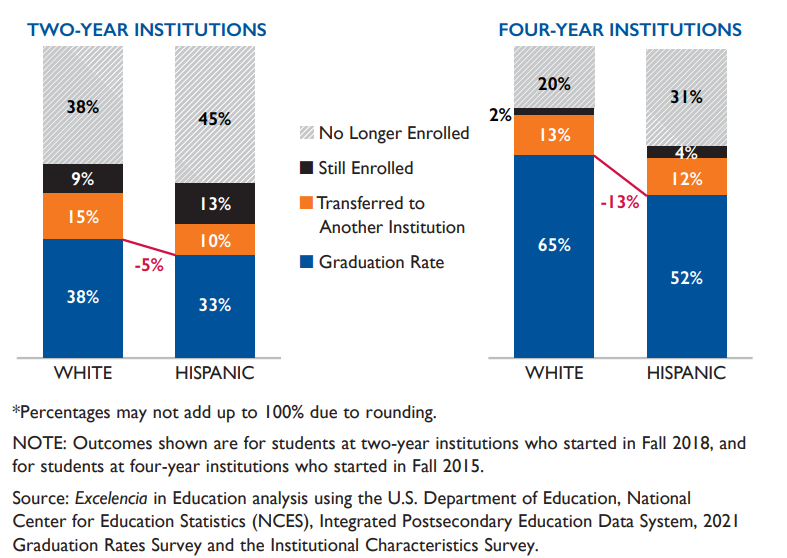
Share On Social!
About half of Latinos who enroll in a four-year college do not end up graduating, according to a new analysis from ¡Excelencia in Education!
Latinos’ college graduation rate (52%) also is lower than their White peers (65%).
How can we increase Latino college graduation rates?
Let’s dive into to the numbers and explore how to close the Latino education gap, and better support Latino students.
Latino College Graduation by the Numbers
28% of Latino adults (age 25 and older) currently have an associate degree or higher, compared to 48% of non-Latino White adults.
To better understand that gap, the new analysis from ¡Excelencia in Education! highlights 4 measures that track degree completion:
1. Graduation Rate: Total percentage of students who graduated within 150% of normal time for first-time, full-time freshmen. This includes students who graduated in 3 years at two-year institutions or in 6 years at four-year institutions. Latinos are behind their White peers in graduation rates for four-year (52% vs. 65%) and two-year (33% to 38%) degrees.
2. Transferred to Another Institution: Percentage of students who transferred to another institution and did not complete a degree. For Latinos at two-year institutions, 10% transferred compared to White students at 15%. At four-year institutions Latinos were at 12%, while White peers were at 13%.
3. Still Enrolled: Percentage of students who transferred to another institution and did not complete a degree. At two-year institutions, 13% of Latinos students were still enrolled, compared to 9% of White students and 4% of Latinos compared to 2% of White were still enrolled at four-year universities.
4. No Longer Enrolled: Percentage of students who are no longer enrolled at the point of 150% normal time to completion. The number of Latino students no longer enrolled were up at two-year universities with 45% compared to 38% of their White peers. The same stands at four-year universities with 31% of Latinos no longer enrolled compared to 20% of White students.

“In combination, [these measures] provide a useful picture of the gap in degree attainment between Hispanic and White non-Hispanic cohorts in a single year,” the analysis said.
The new analysis data also shows that, at two-year institutions, Latinos’ graduation rate was 5%-points lower than that of their White peers.
Similarly, Latinos’ graduation rate was 13%-points lower than that of their White peers at four-year institutions.
Educational attainment varied across the country, too.
New York, Florida, and Wyoming experienced with a robust 30% or more Latino degree attainment.
States with the lowest percentage of Latino degree attainment (15% or less) include Nevada, Oklahoma, and Arkansas.
Causes for the Education Gap
Many factors contribute to the gap in Latino education.
With many Latino students being first-generation, it can be difficult to navigate through college with no prior experience, support, or “cultural capital.”
“In brief, cultural capital helps students have the knowledge and skills that they can draw upon to navigate our systems of higher education, which have specific expectations, norms and values,” Dr. Jafeth Sanchez, an educational leader, told Nevada Today.
Representation on campuses is also a needed element for culture and climate.
“Hispanic/Latinx students are often identified and treated as a monolithic group or as one umbrella term, but Hispanic/Latinx students are very diverse, and it is essential that we support and work to understand this diversity in higher education to remove barriers toward successful completion,” Sanchez said.
Financial stressors and lack of assistance can also deter Latinos from starting and completing their education.
“Many families also lack knowledge of the availability of financial aid and may feel college is impossible to afford—only 44% of Latino parents know about the Pell Grant, for instance,” according to the Independent Educational Consultants Association. “Culturally, Latinos could be quite hesitant about utilizing loans—even for college.”
Further, many Latino families living in rural areas face poverty among other inequities.
“These children may experience lasting effects into adulthood on academic achievement, health, and income,” according to a Salud America! resource.
These barriers make is critical to support Latino students with Latino-focused educational programs and early-college preparation.
“Adequate academic preparation before and while in college is also critical to avoid higher tuition costs and extending time to degree completion due to remedial courses, where Latinos are disproportionally placed,” according to a UnidosUs analysis.
How to Support Latino Students
¡Excelencia in Education! highlighted programs that are working and succeeding in serving Latino students.
The organization has highlighted Dr. Amelie G. Ramirez’s Éxito! Latino Cancer Research Leadership Training program at UT Health San Antonio as an “Example of Excelencia.” Éxito! recruits 25 Latino students and health professionals annually for a culturally tailored curriculum to promote pursuit of a doctoral degree and cancer research career.
In addition, the Latino Promise and HACER (Hispanics Achieving College Education Recognition) programs provide access to higher education by offering associate degree programs with the benefits of a university setting to traditional-aged, Latino students.
“Latino Promise-HACER ensures that primarily first-generation college students can transfer into a bachelor’s program of their choice,” according to ¡Excelencia in Education!
The sister programs are based at Fairleigh Dickinson University-Metropolitan Campus. HACER offers curriculum in Spanish while also teaching students English through ESL; The Latino Promise program offers the same curriculum in English.
“Both programs seek to redress educational, economic, and social barriers by recruiting in immigrant-heavy school districts, offering workshops for families on financial aid and a one-credit course on transitioning to college life which promotes student retention,” according to the new analysis. “The programs provide a pre-college summer program, small classes, academic support, financial grants, personalized advising, and cultural enrichment all designed to mold high school graduates from the local communities into successful college students.”
The organization believes that when institutions measure their postsecondary student success, it can help influence public policy.
¡Excelencia in Education! also included a complete list of institutions in the top-five for enrollments, associate degrees, and bachelor’s degrees among Latinos.
How to Check Your Community’s Health
Supporting and ensuring the health of Latino students is important.
But how can you ensure the health of your community?
Find out by downloading the Salud America! Health Equity Report Card!
The report card auto-generates Latino-focused local data with interactive maps and comparative gauges, which can help you visualize and explore inequities in housing, transit, poverty, health care, food, and education.
You will see how your county stacks up in these health equity issues — now including social vulnerability and COVID-19 — compared to your state and the nation.
Then you can share the Report Card with your local leaders to advocate for healthy change!
By The Numbers
142
Percent
Expected rise in Latino cancer cases in coming years



